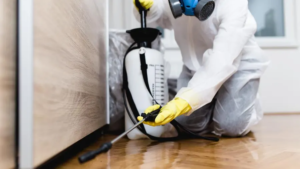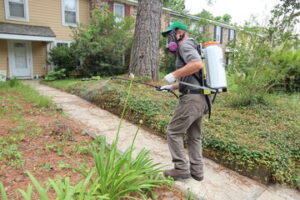Pests are organisms that damage or spoil crops, plants, or buildings. They may also be a health or safety hazard.
You can decide whether action is needed using information about a pest’s biology and environment. This is called monitoring. Click the Pest Control Woodland Hills to learn more.

Look under, around, and on top of your property and house regularly for signs of pests. Eliminate sources of food, water, and shelter for them.
Prevention
Pests can destroy buildings, contaminate food, and harm human health. Preventive pest control measures reduce the need for costly treatments and improve living and working environments. Pests are a constant threat to our homes and businesses, but regular preventive services allow you to stay ahead of them. A professional pest prevention program includes inspections and treatment of the interior and exterior of your property. It also addresses the surrounding area to minimize conditions that could attract pests.
A common mistake in pest management is not identifying and monitoring the factors that influence pest populations, including climate, natural enemies, and availability of food, water, shelter, and other resources. Other influences include the host plant or structure, chemicals in the plant or structure that repel or deter pests, juvenile hormones that keep early stages of insects from maturing into adulthood, and pheromones that affect the behavior of other pests within an area.
Understanding the life cycles of pests allows you to predict their presence and abundance, making prevention more effective. You can also recognize their habits, which vary by species, and take steps to make conditions unfavorable for them. This may involve altering an environment to make it less hospitable, blocking their access, or interrupting their growth and development.
Sealing Entry Points
The most common method of preventing pest infestation is to make the home or business less hospitable by sealing any cracks or crevices. It’s also important to keep garbage bins and other storage areas properly sealed. Moisture is another attractant, so it’s critical to fix any leaky pipes and ensure that any damp regions are adequately dried with dehumidifiers or other mechanical means.
Regular inspections can help identify signs of a pest problem, such as droppings or gnawing. When you spot these signs, contact Safe Pro Pest Control to prevent the pests from damaging your building or posing a health risk. Persistent infestations of certain pests, such as termites or rodents, often indicate that the pests have already established a permanent residence in your building and require immediate attention. This will help you to avoid expensive repairs and potential structural damage.
Suppression
The goal of pest control is to reduce the abundance and damage caused by a species to an acceptable level. This can be accomplished through prevention, suppression or eradication. Prevention is stopping a pest from growing; suppression is decreasing the number of pests to an acceptable level; and eradication means eliminating a particular pest completely. The most common way to control pests is with insecticides, which can be sprayed directly on the plant or in soil. However, because of environmental and human health concerns about these substances, growers and green industry professionals are seeking alternative methods to protect their plants without resorting to chemical treatments.
Insects are the most important pests of crop fields and are responsible for a significant proportion of crop loss worldwide. Natural enemies, including predatory and parasitic insects, are a cost-effective and environmentally friendly option to control pests in agricultural settings. Natural enemy guilds may contribute to pest regulation by direct predation of target insects or through the indirect effects of predatory and parasitic interactions within a group. However, the strength and stability of these interactions may be affected by the context in which they occur.
For example, a natural enemy guild’s ability to suppress pests in an open field can be enhanced by the presence of nearby habitat patches. This is because the spatial arrangement of these patches influences the amount of interaction between different types of natural enemies, as well as the ability of individual members to prey on the pests under their own niche. A study using a landscape-scale model to examine the contribution of different natural enemy guilds to pest control in a winter oilseed rape (Brassica oleracea) field showed that complex and diverse landscapes result in greater overall biological pest suppression.
Another factor that influences the success of natural enemies is the population size of the pest. Generally, larger pests are more difficult to control with biological methods than smaller ones. This is because the larger pests have more resources and can produce more offspring, making them more resilient to natural enemies and more likely to survive even when they are present in low numbers.
Eradication
Pest control aims to prevent and eliminate infestations of plants, animals, or microorganisms. It can be carried out at a small or large scale and may involve natural, biological, chemical, cultural, mechanical, or regulatory methods. Prevention is the most desirable method of pest control, since it is economical and environmentally responsible. It includes frequent cleaning and removal of conditions that encourage pest establishment, while suppression is used to limit pest activity when it is already present. Eradication is a rare goal in outdoor pest situations, but it can be attempted for certain indoor pests in closed environments such as dwellings; schools; offices; health care, food preparation, and retail areas.
Many types of pests carry disease pathogens or allergens that can pose a threat to human health. Regular pest control services can reduce the risk of exposure to these substances, and routine inspections can spot problems before they become serious. It can also help preserve the value of a property by preventing damage to buildings and furnishings.
Integrated pest management (IPM) is a common approach to pest control in homes and gardens. It starts with identification of the pests and monitoring their numbers and whereabouts, and then uses a combination of biological, physical, and chemical controls to manage them. Chemicals and other toxicants can be used in an environmentally responsible way by following the instructions on a product’s label.
Chemical and insecticides are the most familiar and widely used pest control methods. These are generally sprayed on to infested crops, soil, or vegetation to kill or control the unwanted species. In some cases, they are combined with physical controls such as traps and barriers to restrict pest movement. IPM techniques also make use of natural or cultural practices that can affect the environment or the organisms in it, such as modifying planting habits to discourage pests or using biocontrol agents to reduce pest populations.
Another approach to pest control is to encourage the growth of organisms that are natural enemies of the pests, such as parasites, herbivores, or predators. These can be introduced into the environment in small numbers to supplement natural enemies that are already present, or they can be bred in laboratories and released on a larger scale to replace natural ones.
Biological Control
Biological control relies on organisms (predators, parasitoids and pathogens) to reduce pest populations without the use of synthetic chemicals. Unlike chemical pesticides, biological agents do not have any direct impact on people or pets and therefore pose little risk to human health. In addition, biocontrol agents do not develop resistance to their targets, so long-term use of these natural organisms can result in more sustainable pest control.
The three primary types of biological pest control methods are conservation, classical and augmentation. Those practicing conservation biological control focus on enhancing the presence of resident natural enemies to limit pest populations over time. This practice involves changing landscape management practices to favor the survival and activity of these natural predators and parasitoids. In some cases, this is as simple as planting flowers that attract beneficial insects to the home garden. Other times, it is as complicated as introducing new organisms into the landscape to encourage their survival and activity.
Those practicing classical biological control import non-native predators or parasitoids to control invasive pest species. This is often done after a rigorous review and testing of potential agents to ensure they will not harm other species in their native habitat. In some instances, ionizing radiation is used to sterilize prey or hosts for the biological control agent prior to release.
Finally, those practicing augmentation biological control supplementalally release natural enemies to control pest populations. This practice is most often used in greenhouses, nurseries and some fruit and vegetable fields. Supplemental releases of natural enemies may be as few as a few organisms at a critical stage of the season, or inundative releases may involve literally millions of these natural enemies.
Whether it is through the conservation, classical or augmentation of natural enemies, all of these methods can play an important role in integrated pest management programs. They can help to reduce reliance on pesticides, decrease the development of resistant pests and offer a safer alternative for consumers, gardeners and growers. With proper pest identification, knowledge of the biology of the target pest and an understanding of how these natural enemies work together, these beneficial organisms can be a valuable part of a comprehensive pest control strategy.


